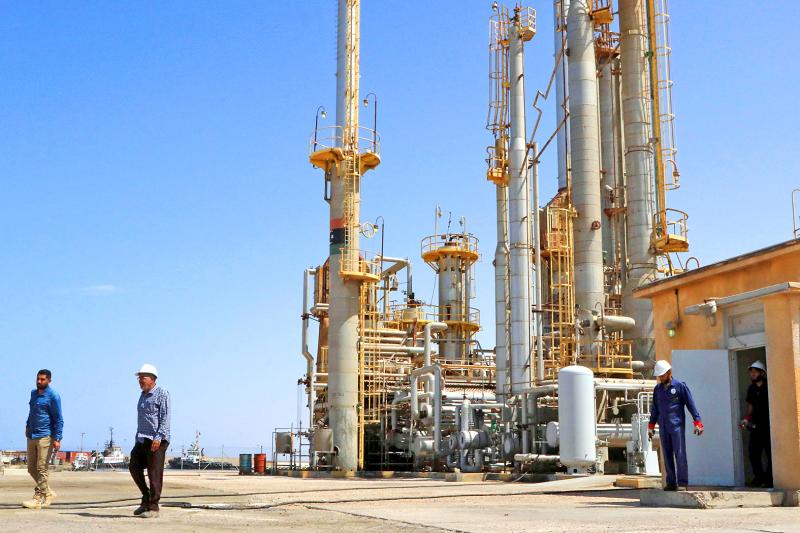Oil on Friday retreated as a further increase in Libyan output threatens to return more supply to a market that is already grappling with a slump in demand caused by the COVID-19 pandemic.
West Texas Intermediate for December delivery slid 1.94 percent to settle at US$39.78 a barrel. It was down 2.69 percent for the week, as a resurgence of COVID-19 infections spurred governments around the world to renew tighter lockdown restrictions.
Brent crude for December delivery fell 1.63 percent to US$41.77 a barrel, losing 2.7 percent from a week earlier.

Photo: AFP
Libya lifted force majeure on its Ras Lanuf and Es Sider ports, and oil output is set to surpass 1 million barrels a day in four weeks, state-run National Oil Corp said.
The announcement came as prospects for more Libyan output increased following the signing of a permanent ceasefire agreement.
Prices were already on the decline as talks appeared to stall on a US stimulus deal before the election, with US House of Representatives Speaker Nancy Pelosi and US Secretary of the Treasury Steven Mnuchin trading blame for the impasse.
A deal would have injected a sorely needed boost to demand, with positive catalysts for prices harder to come by heading into the end of the year.
“The apparent nationwide ceasefire in Libya is only going to encourage more production there and keep it steady, at least for a while,” said John Kilduff, a partner at Again Capital LLC.
Meanwhile, “the COVID situation is not really improving, if not getting worse. So we’re continuing to deal with that as well,” Kilduff said.
While comments from Russian President Vladimir Putin signaling openness to delaying a planned OPEC+ output hike helped bolster prices, the continued return of Libyan production complicates the group’s tapering strategy.
“Until we get a vaccine, prices are probably going to hang out around this range,” said Jay Hatfield, chief executive officer of Infrastructure Capital Advisors LLC in New York. “We need airline travel, and we’re not going to have airline travel until we have a vaccine.”
Despite the prospect of more Libyan supply returning to the market, Brent’s structure remained firm.
The spread between the global benchmark’s nearest contracts strengthened on Friday to its narrowest contango since late July.
Meanwhile, traders’ attention is shifting toward the outcome of the US election in November, which could have varying implications for US supply.
Former US vice president Joe Biden, the Democratic presidential candidate, said that fossil fuels need to be phased out over time, a comment seized on by US President Donald Trump as a threat to the industry.
However, there is debate over how much such a policy would affect oil prices in the near future.
“The transition would take many years and require ample use of fossil fuels in the process,” TD Securities commodity strategists including Bart Melek said in a note. “It is not worrisome for oil markets in the near-term.”
Additional reporting by staff writer.

Among the rows of vibrators, rubber torsos and leather harnesses at a Chinese sex toys exhibition in Shanghai this weekend, the beginnings of an artificial intelligence (AI)-driven shift in the industry quietly pulsed. China manufactures about 70 percent of the world’s sex toys, most of it the “hardware” on display at the fair — whether that be technicolor tentacled dildos or hyper-realistic personalized silicone dolls. Yet smart toys have been rising in popularity for some time. Many major European and US brands already offer tech-enhanced products that can enable long-distance love, monitor well-being and even bring people one step closer to

Malaysia’s leader yesterday announced plans to build a massive semiconductor design park, aiming to boost the Southeast Asian nation’s role in the global chip industry. A prominent player in the semiconductor industry for decades, Malaysia accounts for an estimated 13 percent of global back-end manufacturing, according to German tech giant Bosch. Now it wants to go beyond production and emerge as a chip design powerhouse too, Malaysian Prime Minister Anwar Ibrahim said. “I am pleased to announce the largest IC (integrated circuit) Design Park in Southeast Asia, that will house world-class anchor tenants and collaborate with global companies such as Arm [Holdings PLC],”

Thousands of parents in Singapore are furious after a Cordlife Group Ltd (康盛人生集團), a major operator of cord blood banks in Asia, irreparably damaged their children’s samples through improper handling, with some now pursuing legal action. The ongoing case, one of the worst to hit the largely untested industry, has renewed concerns over companies marketing themselves to anxious parents with mostly unproven assurances. This has implications across the region, given Cordlife’s operations in Hong Kong, Macau, Indonesia, the Philippines and India. The parents paid for years to have their infants’ cord blood stored, with the understanding that the stem cells they contained

Sales in the retail, and food and beverage sectors last month continued to rise, increasing 0.7 percent and 13.6 percent respectively from a year earlier, setting record highs for the month of March, the Ministry of Economic Affairs said yesterday. Sales in the wholesale sector also grew last month by 4.6 annually, mainly due to the business opportunities for emerging applications related to artificial intelligence (AI) and high-performance computing technologies, the ministry said in a report. The ministry forecast that retail, and food and beverage sales this month would retain their growth momentum as the former would benefit from Tomb Sweeping Day